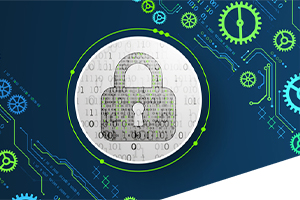In today's digital age, IT security is essential for any business. As our reliance on technology and the internet rises, the risk of cyber-attacks has grown significantly. In addition, cybercriminals target businesses of all sizes, making it crucial to have a strong IT security plan in place.
IT security safeguards computer systems, networks, and other digital assets against unauthorized access, theft, and harm, emphasizing the protection and integrity of these resources. IT security aims to maintain confidentiality, integrity, and data availability. Confidentiality refers to keeping data secure from unauthorized access, integrity ensures data is not tampered with or altered, and availability ensures data is available to authorized users when needed.
Key Challenges that Businesses Face in Protecting their IT Security
- Cyber Attacks: With cybercriminals constantly devising new ways to infiltrate and exploit vulnerable systems, businesses must be prepared for various attacks, such as malware, phishing, ransomware, and social engineering.
- Human Error: Human error could include anything from employees accidentally clicking on a malicious link, sharing sensitive information with unauthorized parties, or using weak passwords that are easily guessed.
- Insider Threats: While external threats are undoubtedly dangerous, insider threats can be just as detrimental to your organization's security.
- Patch Management: One of the most effective ways to mitigate cyber risks is to keep your systems up-to-date with the latest patches and security updates.
- Compliance Requirements: Compliance with regulatory requirements can be a significant challenge, particularly for smaller organizations with limited resources.
- Mobile Devices and Remote Work: With an increasing number of employees working remotely, it's essential to ensure that your organization's IT security policies extend to devices such as laptops and smartphones.
- Lack of Resources: Finally, one of the most significant challenges businesses face in protecting their IT security is a need for more resources, including funding, personnel, and time.
The Basics of IT Security
- Strong Passwords: Passwords should be unique, complex, and changed regularly to prevent unauthorized access. Passwords should also be different for each account to mitigate the consequences of a data breach.
- Software Updates: Updates are released to fix security vulnerabilities, and failure to update software could leave your business open to attacks.
- Firewall: Firewalls are software or hardware devices that supervise and manage network traffic. Firewalls can block unauthorized access and prevent malware from entering your system.
- Antivirus Software: Antivirus software aims to detect and remove viruses, along with various types of malware, from your system. Regularly updating your antivirus software is essential to maintain optimal protection.
- Data Backup: Backing up data ensures that your data is safe in case of a data breach or system failure. Backups should be stored offsite and encrypted to prevent unauthorized access.
- Employee Training: It is crucial to provide employees with training regarding the best practices of IT security, including recognizing and reporting suspicious activities. Additionally, employees should receive comprehensive education on the implications of a data breach and the significance of maintaining robust IT security measures.
- Network Security: Network security includes firewalls, virtual private networks (VPNs), and encryption. Network security ensures that your network is secure from unauthorized access and that your data is safe.
Critical Measures for Ensuring Effective IT Security in Businesses
- Securing Sensitive Data: A well-managed IT security program safeguards the confidentiality and integrity of all data, effectively preventing unauthorized access.
- Avoiding Financial Loss: Businesses can face significant financial losses, including repairing damaged systems, paying ransoms, and losing revenue due to downtime. Adequate IT security can help prevent these losses.
- Maintaining Business Continuity: Cyber-attacks can disrupt critical systems. A robust IT security program helps mitigate the risks and ensure critical systems remain operational.
Best Practices for IT Security
- Use Multifactor Authentication: Multifactor authentication (MFA) is an additional security layer that requires users to provide multiple forms of identification to access a system. MFA can prevent unauthorized access and reduce the risk of identity theft.
- Use Strong Encryption: Strong encryption should be used for sensitive customer and financial data. Encryption keys should be stored securely and changed regularly.
- Use Access Controls: Access controls limit access to sensitive data to authorized users only. Access controls should be implemented at all levels of the organization, from physical access controls to network access controls.
- Implement a Data Retention Policy: A data retention policy can help prevent data breaches and ensure compliance with legal and regulatory requirements.
- Conduct Regular Security Audits: Regular security audits can help identify vulnerabilities in your IT security plan. Security audits should include an assessment of physical security, network security, and software security.
- Cybersecurity Incident Response Plan: A cybersecurity incident response plan outlines how to respond to a data breach or cyberattack. The plan should include procedures for containment, assessment of the damage, and reporting the incident to the appropriate authorities.
- Hire a Security Professional: Hiring a security professional can help ensure your IT security plan is up-to-date and effective.
About Zones Security Solutions
At Zones, our comprehensive Security solutions include a strong emphasis on conducting thorough security assessments. We understand the critical importance of evaluating and fortifying your organization's security posture. Our expert team utilizes industry-leading techniques to identify vulnerabilities, assess risks, and develop robust strategies to safeguard your valuable assets. With Zones, you can gain valuable insights into your security landscape, enhance your defenses, and ensure the protection of your sensitive data. Contact us to know more about how to stay ahead of emerging threats and maintain a secure environment.
![]() Zones
:
May 25, 2023 1:44:45 PM
Zones
:
May 25, 2023 1:44:45 PM



.jpg)